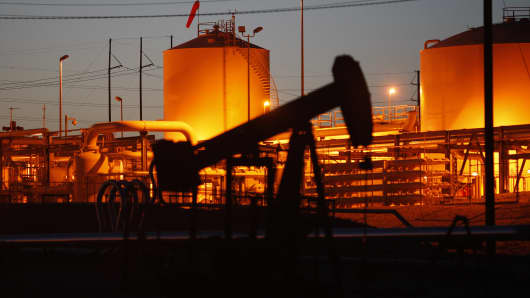US shale pumping means oil is stuck at $50 for the next two years, wealth manager says – US shale pumping oil - Arhive
US shale pumping oil US shale pumping oil US shale pumping oil US shale pumping oil US shale pumping oil US shale pumping oil
US shale pumping means oil is stuck at $50 for the next two years, wealth manager says
- Oil prices are likely to be stuck within a range of $40 to $60 for the next year or more.
- Once oil prices raise towards the $60 per barrel, U.S. shale producers increase output and OPEC members are more tempted to raise production.
- This after the IEA indicated that oil supply increased by 720,000 barrels a day in June.
CNBC.com
Oil prices are likely to be stuck within a range of $40 to $60 for the next year or more, according to the latest investment forecast from U.K.-based wealth manager Coutts.
In its mid-year investment outlook, published Wednesday, the private bank – which is reported to have the U.K. queen as one of its clients – said it expects oil prices to quieten down and stabilize for the medium term.
“After big ups and downs in the last 10 years, we expect the oil price to stabilize in the $40-60 range for the next year or two,” the report said.
“This is partly due to the stabilizing effects of U.S. shale production, which becomes profitable with oil at about $50 per barrel. As a result we don’t expect the oil price to move far from this level.”
Coutts’ explanation for this narrow range is that once oil prices raise towards the $60 per barrel, U.S. shale producers increase output and OPEC members are more tempted to raise production. This increase in supply soon causes the price to fall back. At the other end, oil falling towards or below $40 would cause shale producers to cut output. This, plus steady demand from emerging markets, would push prices back up.
Hans van Cleef, senior energy economist at ABN Amro, agreed with the limited upside potential of oil in the near term.
“I lowered my 2017 year-end forecasts for Brent from $60 to $57 and WTI from $60 to $54. I do see more upside potential for oil prices from (the second half of) 2018,” he told CNBC via email.
“In my view, the market is too negative and ignores the bullish arguments. Strong global demand, declining (U.S.) stocks, the low investments in the sector and a weaker dollar should be supportive for oil prices in the longer term.”
The Coutts investment outlook comes almost a week after the most recent report from the International Energy Agency (IEA). The IEA indicated that oil supply increased by 720,000 barrels a day in June as OPEC compliance with its production cuts seemed to stall.
Meanwhile, focus is turning to OPEC members Libya and Nigeria. The two countries were not required to cut production due to political instability. However, both have managed to increase production significantly in recent months and may come under pressure from OPEC to participate in the supply cuts. But they are unlikely to agree to cuts, according to BNP Paribas.
“Talk of capping Nigerian and Libyan output has been growing fast (within OPEC). But it is very unlikely that both countries will acquiesce to a cap so soon after restoring production,” BNP told Reuters in a report published Wednesday.
Oil prices were higher Wednesday. Brent crude was up 28 cents to $49.12 per barrel at 11:15 a.m. London time, while WTI crude was up 19 cents at $46.59 a barrel, supported by strong gasoline markets. The prices are recovering from recent dips caused by data on Tuesday showing U.S. crude stocks increased by 1.6 million barrels last week to a total of 497.2 million barrels.
Looking at the broader markets, Coutts sees a stable global economy with markets supported by growth in the U.S.
“The investment themes we set out at the beginning of the year have performed well, and we continue to see potential for growth in these areas,” said Mohammad Syed, managing director and head of global markets at Coutts, in a press release.
“In the meantime we’ve added emerging market bonds to our portfolios and funds, to benefit from strengthening economies in the developing world. As ever there are risks on the horizon but uncertain times bring new opportunities into view.”


